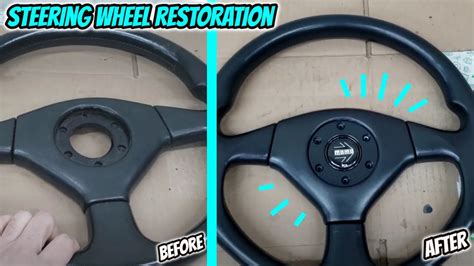Steering Wheel Restoration: Easy Steps for a Stunning Result
Is your car's steering wheel looking worse for wear? Sun-baked, cracked, or peeling leather? A worn-out steering wheel can detract significantly from your car's overall appearance and feel. But don't despair! Steering wheel restoration is a surprisingly achievable project, even for DIY enthusiasts. This guide will walk you through the easy steps to achieve a stunning result, bringing new life to your vehicle's cockpit.
What are the common problems with steering wheels that need restoration?
Many issues can lead to a steering wheel requiring restoration. The most common include:
- Cracked Leather: Sun exposure and age are the primary culprits. UV rays break down the leather's fibers, leading to cracks and dryness.
- Peeling Leather: Similar to cracking, peeling is a sign of deteriorated leather that needs attention.
- Fading Color: Years of use and sun exposure can fade the steering wheel's color, making it look dull and worn.
- Sticky or Worn Finish: The finish on some steering wheels can become sticky or wear away, leaving an unpleasant texture.
- Scratches and Scuffs: Daily use inevitably results in scratches and scuffs, especially on the top and sides of the wheel.
What materials will I need for steering wheel restoration?
Before you begin, gather these essential materials:
- Leather cleaner: Choose a cleaner specifically designed for automotive leather.
- Leather conditioner: This helps moisturize and protect the leather, preventing further cracking and damage.
- Fine-grit sandpaper (optional): If there's significant damage, very fine-grit sandpaper can smooth out rough areas before cleaning.
- Microfiber cloths: Essential for cleaning and applying conditioner.
- Paint (optional): For significant color fading or damage, you might need leather paint to restore the original color. Choose a color that closely matches your steering wheel.
- Protective gloves: Always protect your hands with gloves.
- Soft-bristled brush (optional): Useful for cleaning crevices.
- Masking tape (optional): To protect areas you don't want to be cleaned or painted.
How do I clean my steering wheel before restoration?
Cleaning is the crucial first step. Thoroughly clean your steering wheel to remove dirt, grime, and old conditioner before any restoration work begins.
- Prepare the surface: Use masking tape to protect areas you don't want to clean or paint, like the airbag cover or any surrounding trim.
- Apply the cleaner: Follow the instructions on your chosen leather cleaner. Apply a small amount to a microfiber cloth and gently wipe the entire steering wheel. Work in small sections.
- Remove excess cleaner: Use a clean, dry microfiber cloth to remove all traces of cleaner.
- Allow to dry: Let the steering wheel dry completely before moving on to conditioning.
How do I condition my steering wheel after cleaning?
Conditioning is vital to restore suppleness and protect the leather.
- Apply the conditioner: Apply a small amount of leather conditioner to a microfiber cloth. Work it into the leather using gentle, circular motions.
- Even distribution: Ensure the conditioner is evenly distributed across the entire steering wheel.
- Remove excess conditioner: Use a clean, dry microfiber cloth to buff away any excess conditioner. Avoid leaving any residue.
- Allow to dry: Let the steering wheel dry completely. This process may take several hours.
What if my steering wheel is severely damaged? What about paint?
For severely cracked or faded steering wheels, you may need to consider paint. This is more advanced and requires a careful approach.
- Sanding (optional): If necessary, lightly sand any severely damaged areas using very fine-grit sandpaper to smooth them out before painting. Be extremely careful not to sand too aggressively.
- Applying paint: Use a small brush or sponge to apply the paint in thin coats, allowing each coat to dry completely before applying the next. Multiple thin coats are better than one thick coat.
- Allow ample drying time: Allow the paint to dry completely before applying a leather conditioner.
How do I maintain my restored steering wheel?
Regular maintenance will prolong the life of your restored steering wheel:
- Regular cleaning: Clean your steering wheel regularly with a leather cleaner to remove dirt and grime.
- Periodic conditioning: Apply leather conditioner every few months to keep the leather moisturized and protected.
- UV protection: Protect your steering wheel from direct sunlight whenever possible, as UV rays can cause damage.
By following these easy steps, you can restore your steering wheel to its former glory, significantly improving your car's interior and driving experience. Remember, patience and a meticulous approach are key to achieving a stunning result. Happy restoring!

